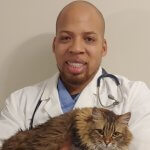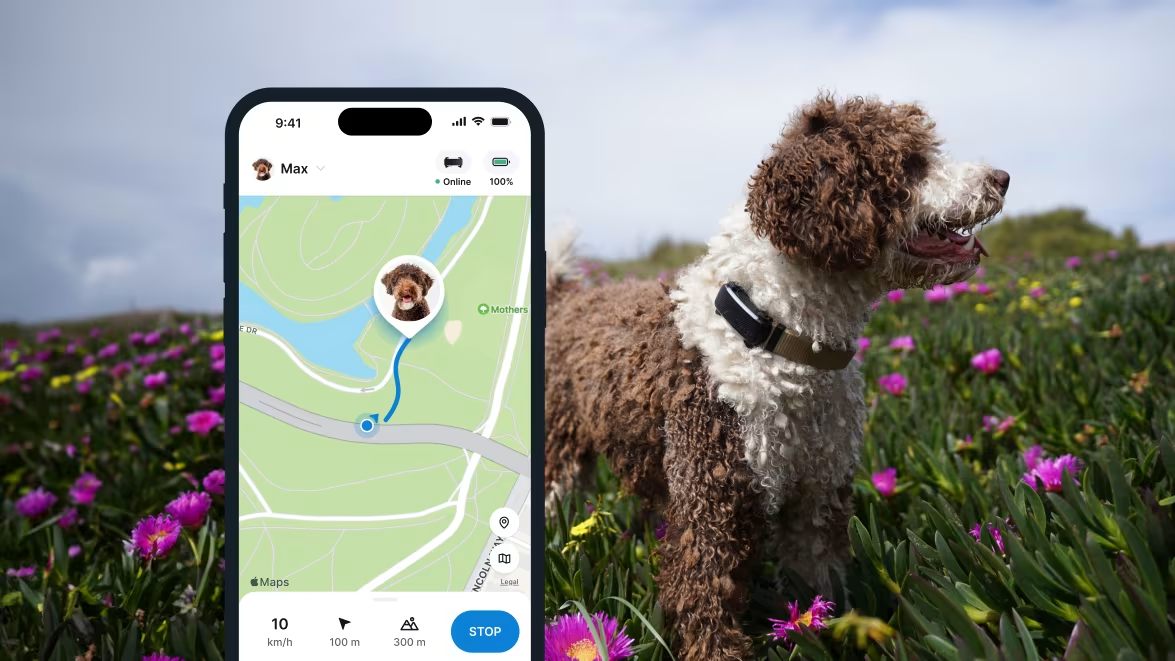 Approved by Dr. Dwight Alleyne, DVM
Approved by Dr. Dwight Alleyne, DVM Bad Breath in Dogs: What’s Causing It & Why
Ever dreaded a "Welcome home!" kiss or if your dog tries licking you...because their breath just smells so funky? Turns out, it could be due to your buddy getting some extra snacks around town - or a more serious health issue. Let's find out.

You definitely aren’t the only dog parent to snuggle up to your buddy on the couch – and end up nearly gagging from the smell as they lick you. Turns out, bad breath in dogs isn’t 100% just a “part of life” as a dog parent. In some cases, it could be a sign of a bigger problem affecting your buddy’s health and well-being.
So let’s dive into why your dog’s breath might be kicking up a stink, what concerning signs to watch out for, and how to figure out if it’s because your dog’s eaten something gross around your neighborhood.

Always know your buddy is healthy & safe
Read more- The #1 cause for bad breath in dogs: Extra “snacks”
- Where is my dog coming across all these…extra “snacks”?
- Outdoor “smelly” spots to keep an eye out for
- Is bad breath in dogs a sign of illness?
- When you should drop by your vet
- How your vet might treat bad breath in dogs
- How to watch out for “forbidden snack spots”
The #1 cause for bad breath in dogs: Extra “snacks”
Now some amount of bad breath isn’t a cause for concern. But if your buddy’s breath has graduated from off-putting to…well, just about unbearable, it may be because your dog’s:
- Eaten something gross, including their own poop, another animal’s poop, roadkill, or even rotten food.
- Eaten something toxic, like certain poisonous plants, cigarettes, or licked a bit of pesticide or some other harmful substance.
- Gotten something stuck in their mouth, including household objects, toys, ropes, sticks, splinters, cloth, and even string.
Now the reasons behind why your dog is eating such…weird things could vary from anxiety to feeling isolated to just learned behaviors. Or your dog could just be teething and needs a little extra attention around their chew toys.
Where is my dog coming across all these…extra “snacks”?
For both indoor and outdoor dogs, you’ll find it helpful to do an extra thorough check of:
- Your garbage bins,
- Under your dining tables,
- Your kitchen counters,
- Your other pets’ litter boxes (especially if you’ve got a cat at home),
- Where your dog tends to do their business,
- Other spots in your house like your backyard and garage, which might include toxic chemicals
- And even whether someone else has been feeding them a few extra bites, licks, and tastes – which could include something off-limits for dogs!
- All of these are common spots your buddy might rummage or scavenge around for some extra snacks – which can lead to bad breath at best, and a serious illness at worst.
Outdoor “smelly” spots to keep an eye out for
Dogs tend to explore the world, nose-first – so whether it’s sniffing around in tall grass or rummaging through your yard (or your neighborhood), they’re bound to come across:
| Garbage and compost | Including trash, compost piles, fertilizer, or even animal remains if they’re feeling extra adventurous. Licking or eating these doesn’t just cause bad breath, but might make your dog very ill from the harmful bacteria and toxins they come across. |
| Other animals | Like deer, rodents, or even other dogs. In some cases, your buddy might end up…well, eating their poop. (Since it might contain nutrients – but also harmful bacteria.) |
| Stagnant water | Like from ponds or puddles nearby. This enables bacteria and parasites like Giardia to enter their system – causing bad breath and tummy trouble, all in one |
| Food scraps | From your neighbors’ houses or any nearby restaurants or the local hotdog stand or even picnicking families nearby. Whether it’s on the kitchen counter or the trash can, unattended food can be risky – especially if it’s spoiled or dangerous for dogs. |
| “Chewable” objects | Like socks, shoes, and toys that have seen better days indoors – or garden hoses, pipes, or sticks outdoors. Anything that leaves behind residue or bacteria can cause bad breath. |
That’s why it makes sense to figure out where your dog tends to spend most of their time. If it’s at your neighbors’, your backyard where the squirrels tend to gather, or elsewhere around your neighborhood – all of these count as places where your dog might end up eating something they really shouldn’t.

Follow your dog anywhere
Get real-time location information, wherever they go. And find out when they try to make an escape, or just when they go somewhere they shouldn’t, with Virtual Fences.
Is bad breath in dogs a sign of illness?
More often than not, eating something weird could either lead to one or more of these medical conditions.
Dental disease
This may result from your dog eating something gross or toxic – or if you’ve been skipping out on their dental care routine. Plaque and tartar buildup can lead to gum disease, tooth decay, and a foul odor.1 In more serious cases, oral tumors – especially in senior dogs – can lead to bad breath. These turn up as masses in your dog’s mouth, which can become infected (and cancerous) over time. So even if you’re brushing your dog’s teeth on the regular, they may still cause bad breath.
Watch out for signs like your dog excessively licking their lips or paws – or seeming more reluctant around meals. These might signal dental pain or difficulties chewing and swallowing.
Liver or kidney problems
If your dog’s breath smells like…well, poop or pee – it could be a sign they’ve eaten either their own poop or another animal’s. Else, it could spell trouble for how their liver and/or kidneys are functioning.2 Much like with us, these organs get rid of toxins and waste materials in dogs’ bodies. When they don’t work properly, these toxins might build up – leading to bad breath.
So if you’re dealing with a case of bad breath in dogs seemingly out of nowhere, take note. Watch out for symptoms like vomiting and diarrhea, since these might signal liver or kidney disease as a root cause.
Gastrointestinal issues
Ever heard of the term “garbage gut”? It’s actually a term vets use to describe the gastrointestinal problems dogs run into when they’ve eaten something from the trash, rotten food, or just something that their systems aren’t designed to handle.3
But besides eating something weird, problems in your dog’s digestive system, like acid reflux or other stomach issues, can also lead to smelly breath. In these cases, the smelly odor could be from your dog’s stomach acids rising up into their mouth.4
In other cases, feeding your dog raw or home-cooked meals may create some stomach problems. (Especially if it disrupts the good bacteria in their mouth or gut.) In these cases, your dog’s mouth may end up developing a Salmonella infection from any raw diets.
Diabetes
Diabetes is a complex condition where your dog’s body can’t properly regulate its blood sugar levels because it’s producing less insulin.6 This leads to it breaking down fat for energy – leading to a buildup of chemicals called ketones. These ketones can change your dog’s breath to an unusually sweet, even fruity odor. Else, watch out for a smell that resembles nail polish remover, like acetone.
Other symptoms of diabetes in dogs might include unexplained weight loss – and peeing more than usual, even if your dog is drinking water like crazy.
When you should drop by your vet
If your dog’s breath improves from regular dental care, being extra careful with their food, and letting any temporary digestive trouble pass – you’re in the clear. But you should consider heading over for a checkup if you notice:
- Persistent bad breath, even with basic dental care or dental treats.
- A loss of appetite,
- Vomiting,
- Diarrhea,
- Excessive drinking,
- Frequent urination,
- Unexplained weight loss,
- Yellowing of your dog’s skin or eyes,
- Pee that has a “chemical” smell – like ammonia
All these could signal potentially more serious health conditions that need the support of your vet right away.
How your vet might treat bad breath in dogs
Your vet might begin by thoroughly examining your dog’s teeth, gums, and mouth to check for signs of dental disease, infections, or growths that could be causing bad breath. If that doesn’t reveal much, they might recommend a blood test to check for any underlying health issues, like diabetes or liver and kidney problems. Based on what turns out to be the culprit, your vet might recommend:
- A professional dental cleaning or even a tooth extraction, if necessary.
- Weekly to daily tooth brushing sessions with special dog-friendly products,
- Special dental chews, toothpastes, water additives, or toys that can help clean your dog’s teeth and freshen their breath,
- A special diet to help balance your dog’s mouth and gut bacteria, as well as prevent plaque buildup.
- Any special medications, including antibiotics, to help deal with any other infections or underlying illnesses.
🥦 It’s also a good idea to get the green light from your vet regarding what foods are best for your dog. They can also recommend steps you can take to prevent your dog from sneaking or scavenging food from elsewhere – which can make all the difference in helping your buddy’s breath stay fresh and clean.
How to watch out for “forbidden snack spots”
For an outdoor dog – or for when you’re taking your indoor dog out on a walk…there’s no end to where they might snarf up something off the sidewalk or come home with a hefty chomp of something toxic. That’s where a dog GPS tracker can help you figure out where your dog might run into something “smelly” in the first place.

Loved and trusted by pet parents around the world, your trusty Tractive GPS helps you track your dog:
- In real-time,
- Over an unlimited range,
- Over a Heat Map of their most-frequented spots,
- And even while on vacation (or 175 countries if you’re on a Premium subscription)
All with just a glance at your phone.
No need to compromise on your buddy’s love for exploring the world, nose-first. Just the peace of mind from knowing you can keep them safe and prevent any extra “snacking” – no matter where they’re off wandering.
Your furry friend’s health and wellbeing means as much as to us as it does to you. So we’ve made it a priority to only share medically-relevant content on our blog. This post was checked, double-checked, and medically verified by Georgia-based vet, Dr. Dwight Alleyne.

Dr. Dwight Alleyne, DVM
Originally from Long Island, New York, Dr. Alleyne began his career at a no-kill animal shelter before becoming a licensed veterinary technician. He graduated from Cornell University Veterinary College in 2006 and completed an internship at Purdue University. Now practicing in Georgia, Dr. Alleyne specializes in soft tissue surgery and ultrasounds. He also writes pet health articles on his website, “The Animal Doctor Blog” (www.anmldrblog.com).



